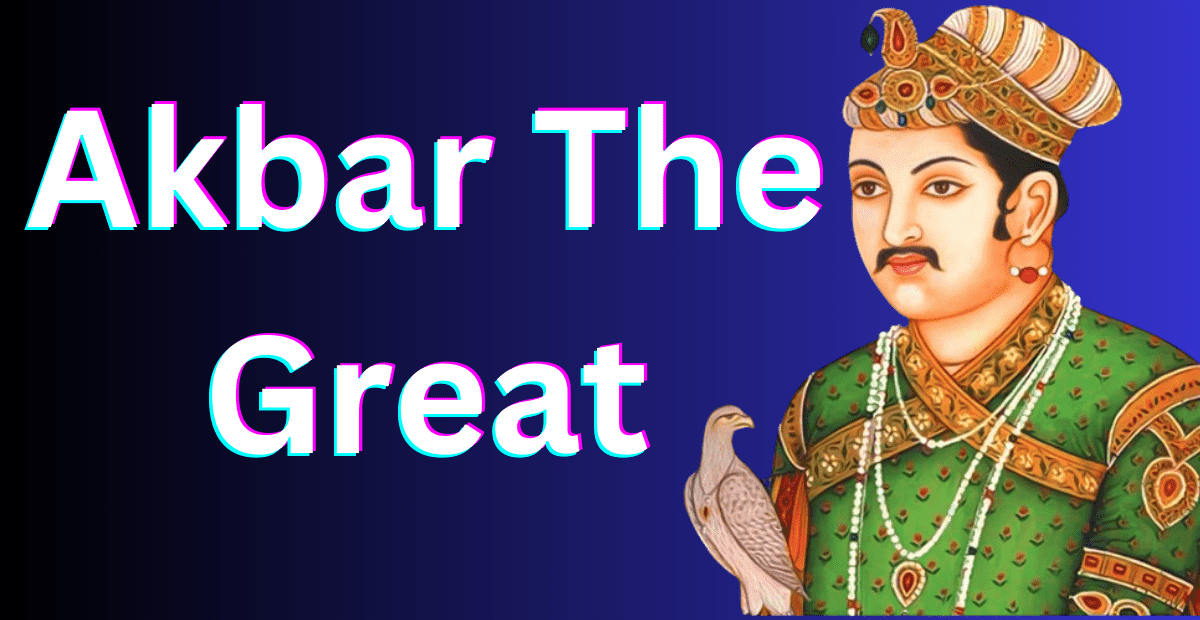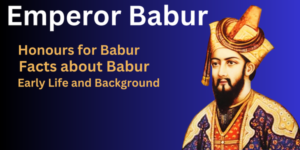Akbar
Facts of Akbar:
Full name: Abu’l-Fath Jalal-ud-din Muhammad Akbar
Born: 15 October 1542, Umarkot, Pakistan
Children: Jahangir, Daniyal Mirza, Shakr-un-Nissa Begum,
Parents: Humayun, Hamida Banu Begum
Died: 27 October 1605 ,Fatehpur Sikri
Akbar ( 1556 – 1605 CE):
He was born in 1542 CE to Humayun and Hamida Banu Begum.He was crowned at Kalanoor in 1556 CE at the age of 13 years.Bairam Khan served as the ruler of Akbar .Hemu represented Akbar in the Second Battle of Panipat against Vikramaditya, leading to the Mughal victory.Under Bairam Khan, Mughal territories extended from Kabul to Jaunpur in the east and Ajmer in the west. Gwalior was conquered.Bairam Khan’s likes and dislikes and arrogance grew in disgust among the nobles.
Akbar removed Bairam Khan, who later died on his way to Mecca.He fell from the fort of Agra on the orders of Akbar as a result of the rebellion of Adham Khan, son of Bairam Khan.Revolts of Uzbek nobles in eastern Uttar Pradesh, Bihar and Malwa ( 1561-1567 CE).Mirzas, the Timurids, revolted, and Mirza Hakim, Akbar’s half-brother, advanced to the Punjab and besieged Lahore.
Early expansion of the Mughal Empire ( 1560-1576 CE):
Akbar conquered northern India from Agra to Gujarat and later extended his rule to Bengal as well.He strengthened the north-western frontier before going to the Deccan.
Gwalior And Malwa:
Adham Khan captured Gwalior and defeated Baz Bahadur, the ruler of Malwa in 1561 CE .Adham Khan’s atrocities led to the rebellion, but Akbar sent another expedition to successfully bring Malwa under Mughal rule.
Gondwana:
Asaf Khan attacked Gondwana in 1564 CE and captured it after defeating Rani Durgavati. She fought bravely, but chose to self-die.
Rajasthan’s success:
Akbar followed the Rajput policy. She married Jodha Bai, inducted Rajputs into service, and established alliances.Effortlessly captured Merda and Jodhpur .The siege of Chittor in 1568 CE marked remarkable success.Despite their defeats, the Ranas of Mewar did not resist and culminated in the Battle of Haldighati in.By 1570 CE, Akbar conquered almost the entire state of Rajasthan.Akbar’s Rajput policy emphasized religious toleration and benefited both the Mughals and Rajputs.
Gujarat, Bihar and Bengal:
Akbar conquered Gujarat in 1572 CE by defeating Muzaffar Shah and Mirzas.The exploited internal conflicts in Bengal, Daud Khan’s rebellion in Bihar, led to his defeat and execution in 1576 CE .The strict enforcement of the Dak organization and religious tensions led to rebellions in Bengal, Bihar and Gujarat.Akbar quickly suppressed the rebellions and restored control in Bengal.expeditions against the Uzbeks and further expansions in Kashmir, Balochistan and Sindh.
Coordination in the Deccan (c1591-1598 CE):
Victories in Orissa, -Bihar and Kathiawar .aggressive policies towards the Deccan ,Prince Murad led the.Battles with the Marathas after the capture of Ahmednagar . Akbar’s death in 1605 CE marked the end of an era.
Administrative structure under Akbar:
Central Administration:
- Emperor:
- The supreme leader controls the military and judicial powers.
- Power to appoint, promote, and remove
- Wazir (Diwan-i-Ala):
- First of all , the position of all-power.
- Akbar reorganized, divided the financial powers and created the post of Diwan-i-Ala for revenue matters.
- He administered the Diwan Khalisa, Inam and Jagir
- Mir Bakshi:
- Head of the Department of Military and Nobles.
- He made military recommendations to the Emperor.
- He headed intelligence and information agencies.
- Mir Zaman:
- In charge of the royal family and workshops (karkhanas).
- Responsible for procurement, production and storage for the royal family.
- Chief Qazi/Sadrus Sudur:
- Head of the Judiciary.
- He supervised charity and religious donations.
- During the reign of Akbar, the Chief Qazi was accused of corruption.
- Mutasibs:
- He was appointed to ensure adherence to discipline, inspect weights and measures, and enforce fair
Provincial Administration (Subhas):
- Subedar (Provincial Governor):
- Directly appointed by the emperor.
- Public law maintained order.
- Diwan:
- Revenue Department Chairman S.P.
- Revenue collection and accounts maintained will be monitored.
- Bakshi:
- He was appointed on the basis of Mir Bakshi’s recommendations.
- It issued paybills and performed similar functions as Mir Bakshi at the Centre.
- Sadar:
- Representative of Central Sadr at the provincial level .
- In charge of the judiciary, he supervises the Qazis.
- Taroghai-e-Taq:
- Responsible for maintaining communication .He sent letters to the court through Merwars (mail runners).
Administration of Sarkar and Pargana:
The sarkar was a regional and revenue division and the pargana was an administrative division.The chief officers included the faujdar (law and order) and the amalkusar (land revenue) in the sarkar.Shikdar, Kwanungo and Kotwals played a role in the administration of the pargana.
Village Administration:
- The village headman (muqaddam), patwari and zamindars played a role in maintaining law and order and collecting revenue.
Land Revenue Administration:
Akbar’s zabti or bandobast system was later upgraded to the tahsala system by Todar Malal.Tahsala system based on Sher Shah’s land revenue system .Uniform system of land survey introduced by Todar Mal.The land is classified as polaj, barauti, chachar and banjar.Takkavi (credit) is given to farmers for cultivation purposes .
Art and Architecture:Akbar
Akbar encouraged indigenous art styles, which led to the common use of sandstone.Notable forts include Agra Fort (red sandstone), Lahore Fort, and Allahabad Fort.
Fatehpur Sikri:
- Fatehpur Sikri, known as the “City of Victory“, was built near Agra.
- The buildings have Gujarati and Bengali
- Jama Masjid and Buland Darwaza (176 feet high) commemorate Akbar’s conquest of Gujarat.
- Notable structures include Jodha Bai’s Palace and Panch Mahal.
Cemetery and Temples:
- Akbar’s tomb at Sikandra near Agra, completed by Jahangir.
- Govinda Deva Temple in
- Jahangir Mahal in Agra Fort.
Paintings and Illustrations:
Akbar presented illustrations of literary and religious texts.Artists from different regions, both Hindus and Muslims, contributed.The works include the Mahabharata and Persian versions of the Ramayana in miniature form.The Hamsanama, which contains 1200 paintings , is a remarkable work.Indian colours such as peacock blue and Indian red were used.
Literature and Language:
Akbar patronized Tansen of Gwalior, the famous composer.Tansen’s ragas, Megh Malhar and Deepak, were believed to influence the weather and The Persian language flourished during the reign of Akbar .Abul Fazl, a scholar and historian, set the style of prose writing.Abul Fazlin Ain-i-Akbari and Akbarnama are the major works.Translation of the Mahabharata into Persian under the supervision of Abul Faizi.Leading Persian poets: Utbi and Nasiri.Hindi poets, including Tulsidas, were associated with the Mughal court. Tulsidas wrote the Hindi Ramayana – Ramcharitmanas.
Mansabdari system:
- Introduced by: Mughal Emperor Akbar 1571 AD
- Meaning: “Mansab” in Arabic means rank or status. “Mansabdari” refers to an officer or officeholder.
- Origin: Originated in Central Asia .
- Types: Initially, 66 variants were installed, but only 33 were used.
- Objective: Unite the nobility, armed forces and bureaucracy into a single administrative body.
- Decimal system: The system was structured within the decimal system to appoint mansabdars.
Jagirdari Organization:
- Consolidation: An integral part of the mansabdari system under Emperor Akbar.
- Division of the region: The region is divided into khalisa (crown land) and jagir (land allocations).
- Revenue collection: The jagirdars received their salary through tax collection under the jagir system and the remaining income goes to the Mughal treasury.
- Khalisa Territory: The revenues of the Khalisa territory directly contributed to the imperial treasury.
- Position Influence: The position of a jagirdar had an impact on the assignment of revenue and revenue responsibilities.
- Role of Mansabdars: Mansabdars held high positions and received large tracts of revenue for collection.
- Revenue terms: The expected income from the area was referred to as “jama ojmadari”.
Religious Policy under Akbar:
Akbar established an empire with equal rights for all citizens regardless of religious beliefs .After marrying Amber Jodha Bai, Akbar abolished the jizya tax and pilgrimage tax to promote religious tolerance.Akbar strengthened his liberal policies by appointing talented Hindus like Raja Todar Mal and Birbal to important positions in the nobility.Originally an orthodox Muslim, Akbar’s religious ideas evolved over time as a result of his deviation from narrow orthodoxy.
In 1575 CE, Akbar built the ibadat khana at Fatehpur Sikri, where scholars from different religions were engaged in religious debates.Scholars include Dastur Maharshi Rana (Parsi), Hira Vijaya Suri (Jain), Purushottam Das (Hindu) and representatives of Christianity.In 1582 CE, Akbar stopped the debates in the Ibadat Khana due to bitterness and condemnation among the representatives of various religions.In 1582 CE, Akbar introduced a new religion called Tin-i-Ilahi.It promotes the belief of one God and Zul-i-Gul, emphasizing equal tolerance and respect for all religious sects.Despite incorporating positive aspects from various religions, Tin-i-Ilahi almost disappeared with the death of Akbar .
End of Akbar’s reign:
- The Last Battle: The final military campaign led by Emperor Akbar was the Battle of Asirgarh in 1601 AD, where he defeated Miran Bahadur, the ruler of Khandesh.
- Result: The battle marked Akbar’s last conquest and showed his military prowess.
- Age of death: Akbar died on 27 October 1605 at the age of 63.
- Place of death: The death of the great Mughal emperor occurred at Fatehpur Sikri.
- Heir: Jahangir, son of Akbar, succeeded him as the ruler of the Mughal Empire.
Nine Gems of Akbar:
| Name | Title/Role | Achievements | Additional Tips |
| Abul Fazl | The great minister, historian | Agnama, the biographer of Akbar | Scholar, Consultant, Historian |
| Faizi | Poet Laureate | Renowned poet, wrote in Persian and Hindi | Akbar’s close companion and friend |
| Birbal | Chief Counsellor, Chief of Army Staff | Known for his intelligence and wisdom, he played an important role in Akbar’s policies | Hindu court captured |
| Todar Mal | Minister of Finance | He introduced the zamindari system and reformed the collection of taxes | Competent administrator, loyal person |
| Raja Man Singh | Army Chief, Governor | He expanded Mughal territory and commanded armies | Rajput prince converts to Islam |
| Abdul Rahim Khan-e-Khana | Poet, diplomat | He composed Persian couplets and served as an ambassador | Descendant of Persian nobles |
| Fakir Aziawuddin | Religious Counselor | Eminent scholar, consultant in religious matters | Sufi saint, highly respected |
| Mulla Do Piazza | Chief Advisor | Held a unique stance, offering alternative views | Legendary figure, stories revolve around his character |
| Tansen | musician | Renowned Hindustani classical musician | Akbar was an expert in vocal music. |




Pingback: Jahangir
I read this post fully on the topic of the difference of hottest
and previous technologies, it’s amazing article. https://Www.Waste-Ndc.pro/community/profile/tressa79906983/
I read this post fully on the topic of thee differrence of hotftest andd previous technologies,
it’s amazinjg article. https://Www.Waste-Ndc.pro/community/profile/tressa79906983/